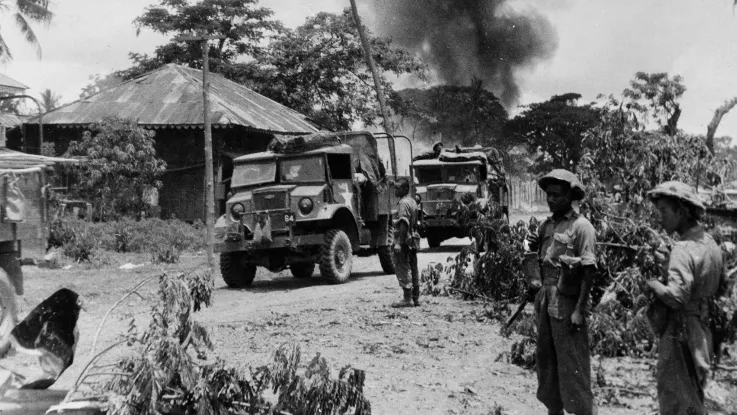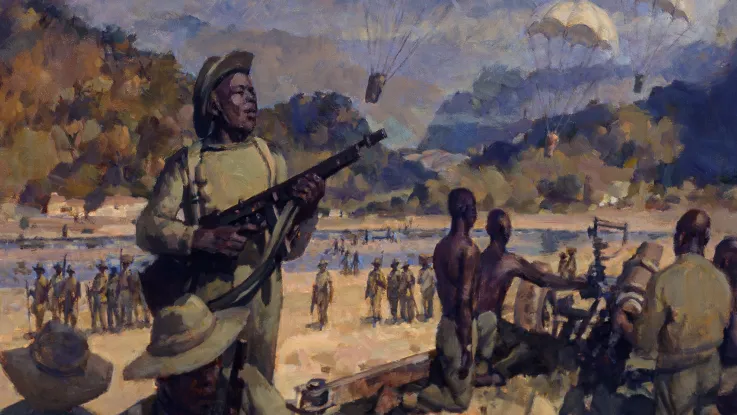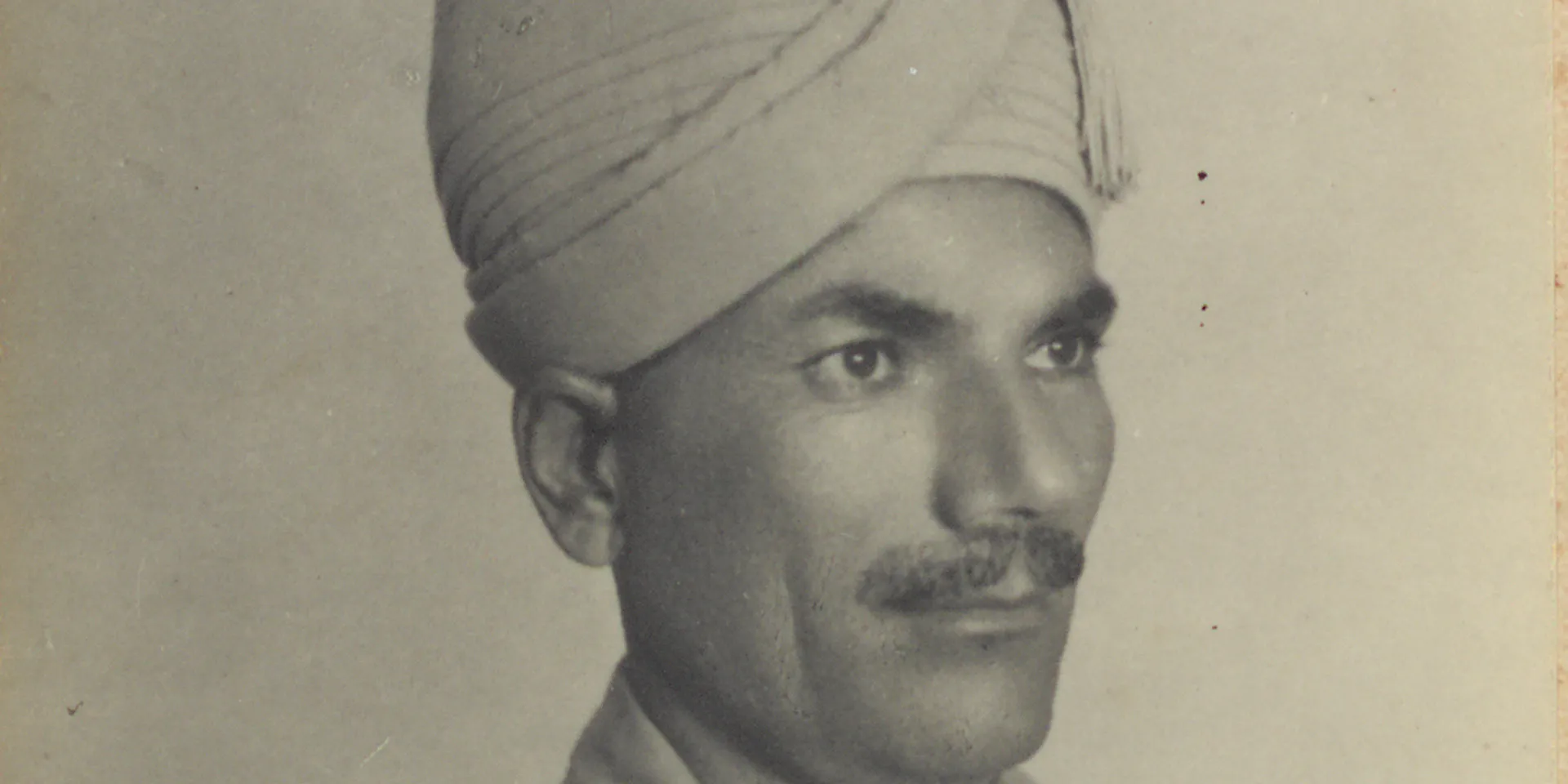
Subedar Makhmad Anwar IDSM, 2/15th Punjab Regiment, c1939
Military career
Makhmad Anwar joined the British Indian Army in June 1918. He served in Waziristan (1921-22) and Burma (1930-31), and was awarded the Indian Distinguished Service Medal (IDSM) in 1936 for his bravery on the North-West Frontier.
He was promoted twice, first to jemadar on 1 April 1930, then to subedar on 10 April 1939. These were Viceroy’s Commissioned Officer (VCO) ranks, unique to the Indian Army, which formed an essential connection between British officers and Indian soldiers.
Throughout his career, Anwar served with 2nd Battalion, the 15th Punjab Regiment. Following the outbreak of the Second World War (1939-45), his unit deployed to Southeast Asia as part of the 6th Indian Infantry Brigade.
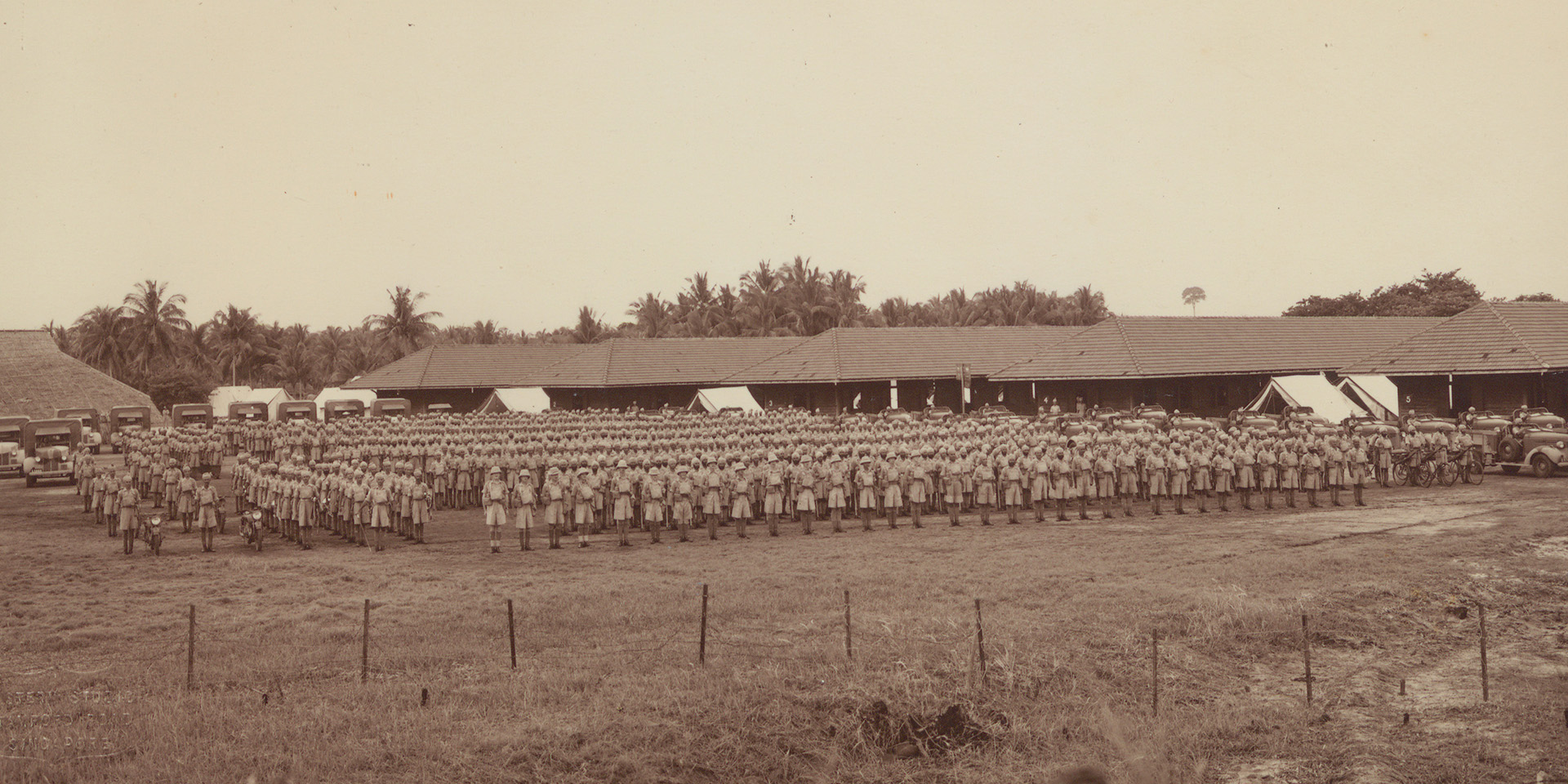
2/15th Punjab Regiment formed up on parade, Stamford Road, Singapore, c1941
Fall of Singapore
On 7 December 1941, Japan declared war on Britain and the United States. Having already attacked the American naval base at Pearl Harbour in Hawaii, it wasn’t long before Japanese forces landed in Hong Kong and other British territories along Asia’s Pacific coast.
By the end of January 1942, Japanese troops in Malaya (now Malaysia) had advanced as far as Singapore, a major military base and the keystone of Britain’s regional defence system. The 2/15th Punjab Regiment had meanwhile been moved to northern Borneo, where it was made responsible for the defence of Sarawak (now part of Malaysia) and Brunei.
On 15 February, the British commander in Singapore, Lieutenant-General Arthur Percival, was forced to surrender to the Japanese in what Prime Minister Winston Churchill described as ‘the worst disaster and largest capitulation in British history’.
Indian National Army
After the loss of Singapore, the prestige of the British Empire plummeted across south-eastern and southern Asia. The Japanese took advantage of this by supporting the formation and operations of the Indian National Army (INA).
The first incarnation of the INA was led by Captain Mohan Singh and recruited largely from prisoner-of-war camps across Southeast Asia. However, Singh became increasingly unpopular with his Japanese paymasters. After his arrest in December 1942, the INA was dissolved on 1 January 1943.
The second incarnation was led by Subhas Chandra Bose, a Bengali nationalist politician. This was made up of Indian soldiers and civilians, formed into three divisions.
In 1945, the INA's 2nd Division faced fellow Indian soldiers of the British Indian Army's 7th Indian Division on the River Irrawaddy in Burma (now Myanmar). It was overrun and in retreat after two days’ fighting, with the majority of its troops deserting or surrendering.
Although flawed as a military organisation, the revived INA posed a significant political threat to British rule in India. In the run-up to independence in 1947, and beyond, its soldiers were widely regarded as freedom fighters.
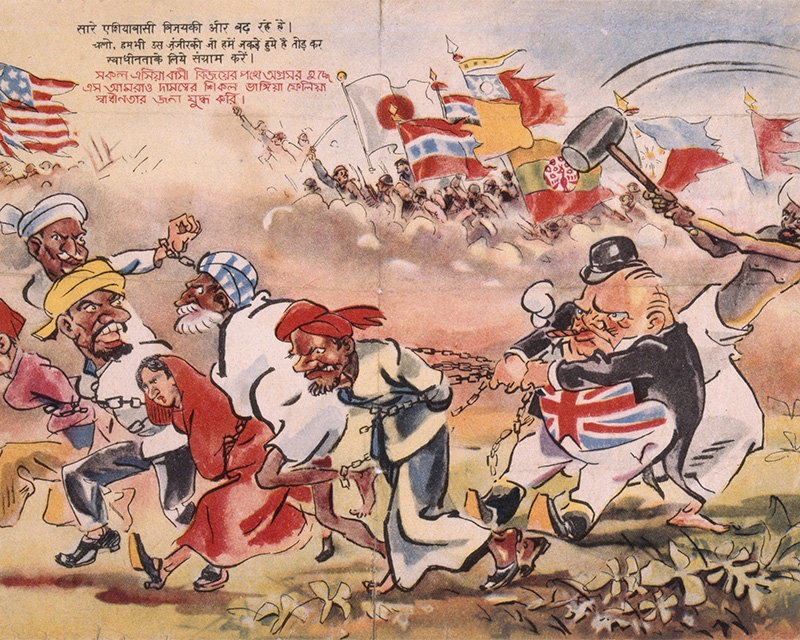
'All Asians are moving towards success. Come, we shall break these chains of captivity and make a revolution towards independence.' [INA propaganda leaflet, c1943]
Prisoners of war
Around 55,000 Indian soldiers were taken captive in February 1942. Many were transferred to camps in New Guinea, New Britain and Bougainville (all now part of Papua New Guinea). They were treated appallingly, both in transit and after they arrived in the camps.
In New Guinea, Hindu soldiers were beaten for refusing to eat beef. Ironically, given the lack of food, Muslim soldiers were prevented from fasting during Ramadan. Sikh soldiers were subjected to forced beard and hair cutting, occasionally with the use of matches.
The subsequent New Guinea war crimes trials uncovered a consistent pattern of beatings, starvation, forced labour regimes and summary executions. Similar treatment was meted out in camps in Singapore and northern Borneo.
A harsh test of loyalty
Despite the hardships endured by Indian prisoners, attempts to recruit them for the INA continued as late as 1945. In Kuala Belait camp in Brunei, refusing to collaborate resulted in severe flogging. Some prisoners were even bayonetted and beheaded.
Interviewed in Australia at the end of the war, Ajit Singh recalled the abuse suffered by some of his fellow captives at Kuala Belait. He explained how one group of officers was locked in a small room with no food and little water for three days.
‘The fourteen Indian officers of our party were drawn up in a single rank in presence of all the sepoys and surrounded by Japanese soldiers. The Japanese drew their swords and soldiers loaded their rifles and closed. Lieutenant Takoda then went along the line and slapped each Indian officer in the face.’Ajit Singh — (AWM54, 779/1/17)
Additional cruelty
After surrendering to the Japanese in April 1942, the officers and soldiers of the 2/15th Punjab Regiment were separated and imprisoned in different camps. Most of the unit’s Indian officers were tortured for refusing to join the INA.
At Kuala Belait, Jemadars Akram Khan, Mohamed Anwar, Lachman Singh and Nazir Hussain were made to dig their own graves before being beheaded. Subedar Makhmad Anwar was singled out for additional cruelty before his own eventual death on 21 April 1945.
‘...due to his seniority and persistent refusals to co-operate, [Anwar] received extra punishments, which in the end caused his death. He was strung up by his feet and beaten twice daily. The wounds caused by these thrashings became septic and he finished up in such a bad state that when he died, during one of these thrashings, maggots had already infected his wounds.Citation for Makhmad Anwar’s Indian Order of Merit — 1947
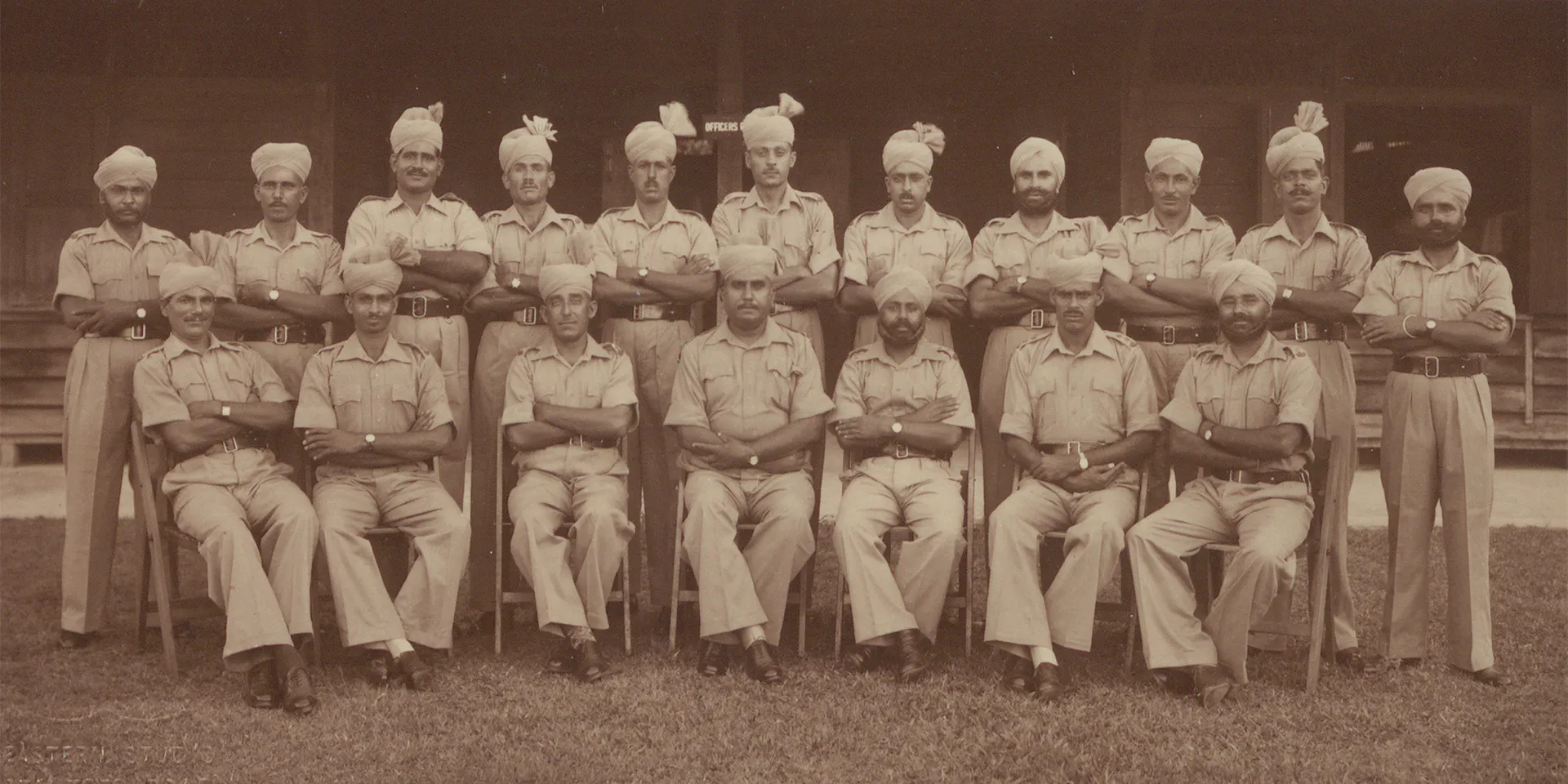
Indian officers, 2/15th Punjab Regiment, Singapore, c1941 (Anwar is seated far left)
Recognition
Anwar was posthumously awarded the Indian Order of Merit, a gallantry decoration second only to the Victoria Cross. The citation recognised his 'courage, fortitude and extreme devotion to duty', reflecting 'the highest traditions of the Indian Army'.
His name appears on the Singapore Memorial alongside thousands of other Commonwealth soldiers who died during the fighting in Southeast Asia, or in subsequent captivity.
His story is just one example of the terrible abuse suffered by so many Indian prisoners of war, something that has been largely forgotten in the historiography of the Second World War.
See it on display
A collection of photographs and medals relating to Subedar Makhmad Anwar's service in the British Indian Army is on display in our 'Beyond Burma: Forgotten Armies' exhibition.

